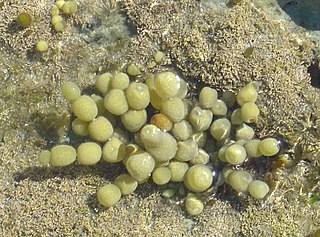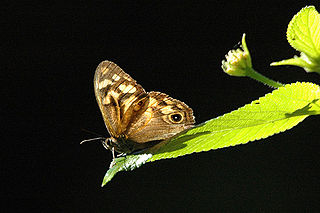
Hormosira banksii, also known as Neptune's necklace, Neptune's pearls, sea grapes, or bubbleweed) is a species of seaweed native to Australia and New Zealand. The genus Hormosira is monotypic.

The red-tailed black cockatoo also known as Banksian- or Banks' black cockatoo, is a large black cockatoo native to Australia. Adult males have a characteristic pair of bright red panels on the tail that gives the species its name. It is more common in the drier parts of the continent. Five subspecies are recognised, differing chiefly in beak size. Although the more northerly subspecies are widespread, the two southern subspecies, the forest red-tailed black cockatoo and the south-eastern red-tailed black cockatoo are under threat.

Eriostemon is a genus of flowering plants of the family Rutaceae. It is native to eastern Australia and includes just two species, E. australasius and E. banksii. Eriostemon australasius, commonly known as pink wax flower, occurs between Fraser Island and Nowra and is a shrub of heathlands and low open woodlands. Eriostemon banksii is endemic to Cape York Peninsula and is a shrub or small tree occurring in heathland and rainforest margins.

Cordyline is a genus of about 24 species of woody monocotyledonous flowering plants in family Asparagaceae, subfamily Lomandroideae. The subfamily has previously been treated as a separate family Laxmanniaceae, or Lomandraceae. Other authors have placed the genus in the Agavaceae. Cordyline is native to the western Pacific Ocean region, from New Zealand, eastern Australia, southeastern Asia and Polynesia, with one species found in southeastern South America.

Grevillea banksii, commonly known as Banks' grevillea, Byfield waratah, red flowered silky oak and dwarf silky oak, and in Hawaii as kāhili flower, is a species of flowering plant in the family Proteaceae and is endemic to Queensland. It is an erect shrub or slender tree with divided leaves with four to twelve narrow lobes, and creamy white to bright scarlet and yellow flowers.

Hypocystina is a subtribe of butterflies.

Viola banksii, commonly known as native violet, is sold and grown throughout garden nurseries and grown and loved in gardens around Australia, especially in the east. For many years it was known as Viola hederacea, however, the species complex was revised in 2004 by Kevin Thiele, with the name Viola banksii being published in 2003 by Kevin Thiele and Suzanne Prober. Although the Native Violet was initially collected by Banks and Solander, the type specimen was either lost or not provided until a collection by Jacques Labillardière in Tasmania. Thiele discovered that the original type specimen of V. hederacea collected by Labillardière was not the same as the hardier and showier plant later collected, cultivated and widely sold. This second form, native to the east coast from near Brisbane to Batemans Bay, he named Viola banksii. This species is distinguished by its striking purple and white flowers. As well, the fully developed leaves are almost circular in outline with a deep, narrow, v-shaped sinus at the base, and are usually rather bright, fresh green.

Drosera banksii, commonly known as Banks' sundew, is a small annual species in the carnivorous plant genus Drosera. The reniform-shaped leaves are attached to petioles and arranged in a circular pattern (rosette) around the stem. The 5 mm wide flowers are white. It is native to northern Australia and Southeast Asia. D. banksii was originally described by Robert Brown and validly published by Augustin Pyramus de Candolle in 1824. It is currently classified in the subgenus Lasiocephala, but expert opinion is that it is misplaced and should be reclassified with the closely allied D. subtilis.

Streblus is a genus of flowering plants in the mulberry family, Moraceae. The genus is found in the Pacific across Southeast Asia, Eastern Australia, New Zealand and the Pacific Islands. Species include:

Heteronympha merope, the common brown, is a species of butterfly of the family Nymphalidae, endemic to the southern half of Australia. The wingspan is about 60 millimetres (2.4 in) for males and 70 mm (2.8 in) for females.

Chicoreus banksii, common name the Banks' murex, is a species of sea snail, a marine gastropod mollusk in the family Muricidae, the murex snails or rock snails.

Telicota brachydesma, the small darter, is a butterfly of the family Hesperiidae. It is found in Australia, the Aru Islands, Papua Province and Papua New Guinea.

Heteronympha is a genus of butterflies in the family Nymphalidae. The genus contains seven species.

Eucalyptus banksii, commonly known as the Tenterfield woollybutt, is a tree that is endemic to eastern Australia. It has rough fibrous or flaky bark, lance-shaped to curved leaves, flower buds without a pedicel in groups of seven in leaf axils, white flowers and hemispherical to cup-shaped or conical fruit.

Musa banksii is a species of wild banana, native to New Guinea and Australia (Queensland), and most likely introduced to Samoa. It was first described by Ferdinand von Mueller in 1863 from plants collected in Queensland, Australia. Thereafter, taxonomists have variously treated it as a unique species or as a subspecies of Musa acuminata. The first one to note an affinity with Musa acuminata was Ernest E. Cheesman in 1948. In 1957, Norman Simmonds reclassified it as a subspecies of Musa acuminata based on extensive field observations in New Guinea, Australia, and Samoa. In 1976, George Argent chose to treat it as a species.

Carex appressa, the tall sedge, is a species of flowering plant in the family Cyperaceae. It is native to New Guinea, Australia, New Zealand, and generally in the South West Pacific.

Heteronympha cordace, the bright-eyed brown, is a brown colored butterfly endemic to Australia. It was described by Carl Geyer in 1832.

















